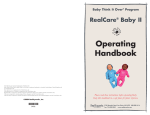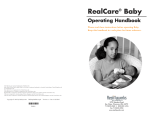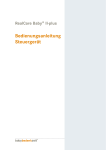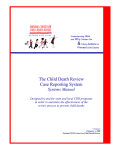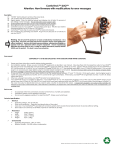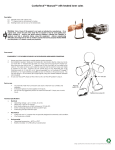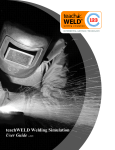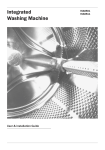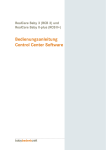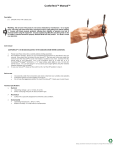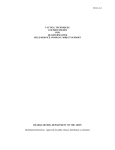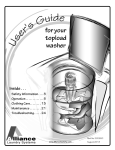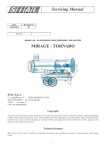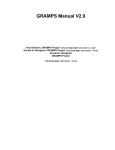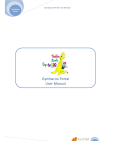Download Baby think it over guide
Transcript
Baby Think It Over Program ® Instructor Handbook 4 GENERATION VERSION 4.7 The Baby Think It Over® Program Instructor Handbook The Baby Think It Over® Program TABLE OF CONTENTS Introduction ...............................................................2 Terminology...............................................................2 Part I: Preparing for the Program .........................3 Introducing Baby ...............................................3 Enlisting Community & Media Support ........4 Gathering Equipment .......................................5 Assembling Written Materials ..........................6 Babysitters ...........................................................7 Forms & Activities Before the Parenting Simulation .................................8 Part II: Conducting the Parenting Simulation ......9 Assigning Baby ...................................................9 Issuing Baby......................................................10 Forms & Activities While the Student Has Baby ....................................11 Ensuring Proper Participation .......................12 Part III: After the Parenting Simulation ..............13 Forms & Activities...........................................13 Evaluating Student Performance...................13 Analyzing Changes in Attitude ......................14 Part IV: Instructor’s Guide to Forms & Worksheets ..............................14 Part V: Worksheets..................................................19 Realityworks, Inc. 2709 Mondovi Road Eau Claire, Wisconsin USA 54701 715.830.2040 • 800.830.1416 Fax 715.830.2050 www.realityworks.com [email protected] The following are registered trademarks of Realityworks: Baby Think It Over and the Baby Think It Over logo are registered trademarks in Australia, Canada, Japan, United Kingdom, and the United States only. Baby Talk It Over is registered in the United States only. Some Decisions Last A Lifetime is registered in the United States only. RealCare Baby is registered in Australia, European Community, Mexico, New Zealand, and the United States only. NICoteen is registered in Australia, Japan, Mexico, Singapore, and the United States only. NICoteen logo is registered in Australia, European Community, Japan, Mexico, New Zealand, Singapore, and the United States only. Copyright © 2006 by Realityworks Item #D31D *D31D* Instructor Handbook The Baby Think It Over® Program Instructor Handbook INSTRUCTOR HANDBOOK (Generation 4) Please read the Baby Think It Over Operating Instructions before you read this manual. Introduction The Baby Think It Over Program is designed as a modular program to be incorporated within and complement your subject curriculum. While the Program provides a reasonably realistic simulation of parenting, there are significant differences between Baby Think It Over and a real infant. It is important for the instructor to educate students about these differences. Baby cannot smile and interact like a real infant, but is very lifelike in appearance. Each ethnic version has different facial features; they are not the same Baby with different skin tones. Many types of funding are available to expand your program. Thousands of Babies have been purchased through grants or donated by organizations. Call us for tips and assistance in locating funding sources. A Drug-Affected Demonstrator is also available. Including this model for classroom use can contrast the normal healthy Baby sent home with students and an infant born affected by drugs. It is most effective when used after the students have participated in the Baby Think It Over parenting simulation with normal infant simulators. The Program is used by hospitals, teen shelters, churches, social service agencies, and other organizations, but because the majority are used in schools, this handbook focuses on that environment and its terminology. Page 2 No two schools or communities are identical and will not conduct the Baby Think It Over Program in exactly the same manner. To be effective, however, there are basic elements of the Program that must always be incorporated. Failure to include any one of the basic elements of the Program may significantly affect the desired outcomes. If you have a new idea or suggestion for inclusion in the Baby Think It Over Program, please contact us at: Marketing Department Realityworks, Inc. 2709 Mondovi Road Eau Claire, Wisconsin 54701 Phone: (800) 830-1416 or (715) 830-2040 Fax: (715) 830-2050 Email: [email protected] Terminology Baby Think It Over® infant simulator, and Babyterms for the computerized infant. Baby Think It Over Program® and Programthe combination of the three important components that make the program work: • Baby and Accessories • Equipment • Activities and Assignments Parenting simulationthe experience of caring for the infant simulator for a minimum of 48 hours. An effective parenting simulation should include all three program components listed above. Parent, Student or Teen the person who cares for Baby during the parenting simulation. Instructor the adult supervising the students during the parenting simulation. Electronics box the small computer that fits in the back of Baby Think It Over. Care key the small plastic device worn on the teen’s wrist to care for Baby. Care session caring for Baby when it cries by inserting the care key in its back. Neglect event failure to respond to Baby’s crying for one minute or more. Neglect events are recorded by the electronics box. Rough handling event an instance of physical mistreatment of Baby, either deliberate or accidental, including dropping or hitting, that is recorded by the electronics box. The Baby Think It Over® Program Instructor Handbook PART I: PREPARING FOR THE PROGRAM SECTION A: Introducing Baby Introducing Baby at School The superintendent, school board members and principal are usually excited about new, innovative approaches to parenting education and teen pregnancy prevention. Their support Caucasian infant simulator shown Ideally, you should hold a meeting to gain the support of faculty and staff and to respond to any questions or concerns. An easy way to familiarize your staff with the Program is to show the video “Some Decisions Last A Lifetime.” If you cannot hold a special meeting, introduce Baby at a faculty meeting or send a memo. The meeting or memo is an opportunity to correct any misconceptions. For example, at one school the faculty thought the infant simulator cried throughout the entire one- to thirty-minute care session, and were understandably opposed to students bringing Baby into their classrooms until this was clarified. A good channel of communication will allow you to make adjustments for special circumstances and events, such as working with coaches for sporting events, or with bus drivers for transporting equipment on the bus. Getting Your Colleagues Involved is important because it could result in additional funds for the Program, and because they usually decide whether Baby will be allowed in classrooms. Faculty and staff can watch for unattended, mistreated, or improperly held Babies, since these are behaviors the electronics box cannot monitor. For example, picking Baby up by an arm or leg is inappropriate. Laying it on a desk or table and walking away is not proper care. Teen pregnancy prevention and parenting information can be incorporated into many other classes: Page 3 The Baby Think It Over® Program Instructor Handbook • • • • • Math or Economics - assign students the task of estimating the cost of an infant. English - assign books about teen pregnancy such as Baby, Baby, by Liz Nichols, Too Soon for Jeff, or Detour for Emmy, both by Marilyn Reynolds. Physical Education - focus on the importance of pre- and post-natal fitness. History and Sociology - study parenting throughout history and changes in attitudes toward teen pregnancy or single-parent families. SECTION B: Enlisting Community & Media Support Driver Education - teach proper use of car seats and how to handle distractions (such as crying babies) while driving. Introducing Baby to the Student’s Family Since the student will have Baby for several nights, the family can play an important role. Parents are usually very enthusiastic about the Program and want to help. You may send home the Letter to the Student’s Family included in this handbook, which explains ways the family can help. You may also want to have an open house or special meeting for parents to attend. Most parents are eager for their children to participate. However, a few parents may choose to keep their children from participating. If a student says a parent objects, be sure you receive a completed Parent Consent Form that did not give per mission. A Parent Consent Form is included in this handbook. Introducing Baby to the Students Allow at least one day of class time before Baby is issued to let students get acquainted with Baby. Demo mode works best for this introduction. Decide how many minutes each student should hold Baby in class. Allow extra time for care sessions. The care key should be sent around the room with Baby, not attached to a student’s wrist. If Baby cries, the student holding it must quiet it. Page 4 Hands-on use of Baby before going home with the student will answer questions about use of the care key. African-American infant simulator shown Community & Service Organizations Many organizations have sponsored the Baby Think It Over Program. Often such groups are already looking for worthwhile projects to sponsor. They can lend both hands-on assistance and financial support. Hospitals Hospitals want to help reduce teen pregnancies and may be willing to donate infant simulators, wristbands, and car seats to your program. They may have speakers available as well. Law Enforcement Officers understand the need for car seat safety education. In some communities special tickets are issued to students who fail to use car seats with Baby or use car seats improperly. One copy of the ticket is issued to the student; the other is sent to the instructor. The tickets affect grades and impact the budgeting worksheets. Some police departments have money available for car seat safety programs and have purchased the car seats to be used in the Baby Think It Over Program. Media Newspapers and radio and television stations are always looking for local human interest stories. Hundreds of newspaper and television pieces have appeared featuring schools and organizations using the Baby Think It Over Program. Give your local media a call. The publicity shows your school or organization in a favorable light, and may result in funding to expand your program. The media can let the community know what you need for equipment and supplies. SECTION C: Gathering Equipment Requiring students to use equipment is an integral part of the Program. In addition to making the parenting simulation as realistic as possible, it teaches the planning, money, time, and work involved with an infant. Baby will take up some of their space as well as their time. Equipment Options: • • • • • The school can provide everything. The school can provide the basics and offer extra credit for additional equipment the student supplies. The school can have some equipment for students who can’t find equipment. Students who borrow items should take the rental fee into consideration when computing expenses and budget for Baby. The students can be required to borrow or improvise for all the equipment and may lose grade points for missing items. Each system has its own merits and short- comings. Although it is nice to have new equipment uniformly issued by the school, used equipment of various styles allows students to compare features to consider when purchasing equipment. You may want to combine several methods if equipment was not included in your funds: • • • • • • • Students can borrow from friends and relatives. A note sent home with students can generate donations. Put an article in the school newspaper and send a press release to your local media. Be specific about the type of equipment needed, especially clothing and strollers. If your local hospital has a program for new parents that provides diaper bags or car seats, the hospital may be willing to donate some. Contact local stores for donations and possible discounts. A baby shower within the community can be used. Watch garage sales and thrift stores for bargains. Sometimes the sellers will donate the items if they know why you are buying them. The Baby Think It Over® Program Instructor Handbook Recommended Equipment: Diaper Bag The diaper bag should be as full and heavy as one for a real infant. A suitable substitute can be a gym bag or even a shopping bag. It should not be too small. The clothing and blankets the student uses for Baby will easily fill it, but you should consider ensuring weight. A parenting book can be added to the bottom of the bag. You can require students to fill baby bottles with water. If the student chooses the breast feeding option, they could include breast pads or a breast pump. Cans of formula also add weight. Rather than purchase formula, each student could bring two cans of food from home. Cover the cans with plain paper and label them “Formula.” After the simulation, students may take the canned goods back home or donate them to a food pantry. Many hospitals have donated sample product packages like the ones sent home with new mothers. The oil, lotion, powder, and other items add weight to the bag. Page 5 The Baby Think It Over® Program Instructor Handbook Stroller or Infant Carrier Infant strollers allow Baby to lie flat. Umbrella strollers do not provide adequate neck and back support for a newborn. It is important that the teens understand when each type of stroller is appropriate. Car Seat If a student will be in a car or bus, Baby needs a car seat. The infant type that does not position Baby completely upright is preferred. The car seat must face the back of the vehicle, not the front. Surveys have found that a large percentage of adults do not know the proper use of infant car seats. The Baby Think It Over Program may provide the only training some teens get before they become real parents. Crib, Cradle, or Bassinet Giving Baby its own bed shows the teen that space will be taken up by Baby. If a crib is not available, the student can substitute a laundry basket, cardboard box, or dresser drawer lined with blankets or towels. The bed should be in the student’s room, taking up part of the student’s space. Clothing should also include blankets and other related supplies. SECTION D: Assembling Written Materials Materials given to the student consist of two types: Textbook materials are read and returned to be used again by the next student. Pocket materials are used up and must be replenished for each student. The center of the Student Handbook holds the reusable textbook materials and the pocket holds the consumable pocket materials. Textbook materials may include: Clothing • • • Shaken Baby Syndrome information Clothing that works well: • • • Worksheets that students answer on a separate sheet of paper, allowing the worksheets to be reused Access to Baby’s back for the care key must be taken into consideration. • two-piece outfits • drawstring nightgowns • one-piece outfits that open in the back • clothing modified with an opening in the back Clothing that does not work as well: • • one-piece outfits that open in front two-piece outfits with straps or bib fronts Students may be offered extra credit for modifying clothing to accommodate the care key by making a finished opening in the back. A parent or other volunteer can help. Page 6 getting a snowsuit on and off can be substantial. You can require that Baby wear a sweater, jacket, or snowsuit every time it goes outside. This shows the teen the inconvenience of dressing and undressing an infant. Time spent Student Handbook Car seat safety information Sudden Infant Death Syndrome information Other related information from your curriculum Pocket materials may include: • • • • Parenting Contract Parent Consent Form Birth Certificate Worksheets that you photocopy for the student to fill out In preparing the written materials, decide which forms will be textbook materials and which will be pocket materials. Assemble sets of pocket materials for all your students at one time. Each time Babies are issued, simply insert a new set of pocket materials in each Student Handbook pocket. Materials that may be either textbook or pock- et forms are: • Readiness Quiz • SIDS Quiz • Shaken Baby Syndrome Discussion Topics • Car Seat Safety Quiz • Pre-Simulation Questionnaire • Post-Simulation Questionnaire • Diary • Baby’s First Year Expense Worksheet • Budget Worksheets SECTION E: Babysitters There are two basic approaches to Baby in class. Some people feel that to best simulate the constant care a new parent would provide, the student must carry Baby everywhere. Since the student is in school, Baby goes to class. The other view is that a real infant would be in day care, not class, so Baby should be in child care. Both are realistic approaches. If a day care center or babysitter is used, the teen should pay for the service using real or play money, or by taking a turn as a babysitter for other students. You may wish to have students repay a babysitter’s time with their own valued time. Teens should learn that employers, co-workers, and family do not always cooperate in helping a new parent juggle responsibilities. They will not always have a babysitter available. There may be places they want to go that will not allow babies. Guidelines for babysitting should be given to students before they begin their parenting simulations. Day Care During School During school, day care can be permitted for one class period at a time or all day. If the student leaves Baby only for the periods in which it can not be in class, choose a location central enough to accommodate the student’s need for dropping it off between classes. If only a few Babies require day care each period, day care can be in your classroom. Students in the room that period can be assigned to care for them. This can be a way that students repay time spent leaving their Babies in day care. If too many Babies would be in the classroom at once, other arrangements must be made. Some schools have creatively solved their babysitting needs by using: • a playpen in the principal’s office • volunteers who set aside an area in the cafeteria or gym • the nurse’s office • a developmentally disabled classroom • the school day care center for children of students • a real day care center near the school (for care all day) The Baby Think It Over® Program Instructor Handbook If Babies must be in day care the entire school day, leaving them in your classroom before the start of school each day may work for any number of Babies. If you wish to turn them off during this time, record the LED display numbers when the Babies are dropped off, then disconnect the batteries. Activate Babies at least five minutes before the students pick them up again. Disconnecting the batteries after noting the electronics box display for each Baby means they need no care during the school day. If you require students to visit their Babies during the lunch hour, disconnecting them would not be a practical approach. One school found the Program to be a good way to accomplish mainstreaming of developmentally disabled students with the rest of the student body. The day care was established in that room and all students left their Babies during the school day, but visited them during the lunch hour. The developmentally disabled students provided care for the Babies during the day and reported on their activities when the students visited and picked the Babies up at the end of the day. For babysitting during school functions such as drama, music, or sports events, consult the teacher or coach in charge of the event to determine the best arrangement. Wearing the care key may be a problem. When arrangements are made in advance, coaches and teachers are usually willing to reattach care Page 7 The Baby Think It Over® Program Instructor Handbook keys after the event, if they are provided the necessary wristbands. Babysitting A fter School Babysitting after school should be kept to a minimum because students should spend as much time as possible with Baby. Babysitting should be available only when it would be impossible, not merely inconvenient, to care for Baby. The shorter the parenting simulation, the more important it is that very little babysitting is used. If babysitting is a common need, paired parenting should be considered. (See page 9.) Possible Babysitting A rrangements 1. Students may watch each other’s Babies, but there is the chance both will cry at the same time and the sitter can only care for one. Assuming the sitter’s Baby will be the one cared for, the second Baby would be neglected. The sitter should make a note of it in the neglected Baby’s diary. 2. Other students can be authorized sitters to repay their own use of a sitter during their parenting simulation. You should let students know who the authorized sitters are. Because of the flexibility this offers the student, this arrangement isn’t recommended unless the students will have Baby for several nights, usually at least a week. 3. Volunteers from service organizations or the parents of the teens can provide the child care required. You can give the volunteers a schedule of students authorized to receive babysitting. Instruct students that the babysitting must be approved in advance for them to use this service. 4. Parents of the students may ask to serve as babysitters during special events such as a wedding in which the student is an attendant. It is best if the parent picks up and returns the spare care key on the day surrounding the event rather than allowing the parent to have the care key for the entire parenting simulation. Page 8 SECTION F: Forms & Activities Before the Parenting Simulation Use the following forms and activities prior to issuing Baby. Suggested uses for the forms can be found on page 14. • • • • • • Letter to the Student’s Family • • • • • Car Seat Safety Quiz Parent Consent Form Student Handbook Readiness Quiz SIDS Quiz Shaken Baby Syndrome Discussion Topics Pre-Simulation Questionnaire Inventory Sheet A ssignment Checklist Expense Worksheet & Budget Worksheets • Guest Speaker You may want to invite a guest speaker, such as a nurse, doctor, or other health official, to talk to your students about parenting an infant. • Baby’s Name The student should decide on an appropriate name that will appear on the birth certificate. Ridiculous names that no one would give to a real child should not be permitted. Possible topics for class discussion are: family traditions, meanings of names, different spellings, initials for monograms, and nicknames. Some classes prefer to select a single name that all students use for Baby. PART II: CONDUCTING THE PARENTING SIMULATION SECTION A: Assigning Baby How you choose to assign your infant simulators may be determined by your class size, schedule, and how many you have. The recommended minimum for a parenting simulation is 48 hours for middle school students and four to seven days for high school students. The parenting simulation will have a greater impact on the teens if they must make lifestyle adjustments for longer periods of time. Monitor data every two to three days to insure accurate results. Simultaneous Parenting In this scenario, all students care for infant simulators at the same time. This is feasible when you have a one-to-one ratio of infant simulators to students. Simultaneous parenting allows you to finish the parenting simulations much faster, but may require a little more planning up front. The concurrent experience facilitates class discussion. Back-to-Back Parenting If you have only a few infant simulators, exposing the entire class to the parenting simulation will take much longer, but results in a continuous, semester-long dialog on the responsibility of parenting. For middle school students, you may wish to issue the infant simulators from Monday to Wednesday, Wednesday to Friday, and Friday to Monday. This way, if you have two infant simulators, you can get six students through the parenting simulation in a week. For high school students, you may wish to issue Babies for one week, choosing one day of the week for this task. Paired Parenting Assign Baby to two students for parenting jointly. The pair can be of the same or different genders. Each student has a care key attached with a wristband. This arrangement emphasizes the cooperation and sharing of responsibilities required by actual parenting. The pair will negotiate when each cares for Baby. This may be a good way to issue Baby if students have employment or sports activities. While one is at work or practice, the other cares for Baby. The Baby Think It Over® Program Instructor Handbook Mixed Simulations You may combine the Baby Think It Over Program with other types of simulations, such as flour sack babies or egg babies, so that all simulations run concurrently. If students use Babies for a certain number of nights and other types of simulators on the other nights, Babies should be issued after the other types of simulators, not before. Students can compare and discuss the similarities and differences between Baby Think It Over, flour sacks, and real babies. “Made-To-Order” Baby Some students may request a specific gender or ethnicity of Baby. Remind students that in real life they may not have that choice. They also cannot select Baby’s temperament. Some parents get contented babies; some have fussy ones. Accordingly, the infant simulators given to students may have various temperament settings. It may seem desirable to assign a teen the infant simulator that bears the most resemblance to the student, but that is not the only approach. If you have simulators of several ethnicities, there are several approaches you may use: • • Match the ethnicity of Baby to the parenting student. This increases the likelihood others will mistake it for a real infant. Number each Baby, place the numbers in a hat, and let each student draw. Drawing Page 9 The Baby Think It Over® Program Instructor Handbook • Baby’s number is usually a highlight for students. Is it a girl? Is it a boy? Exciting for some, but disappointing for others, this can be the start of simulating realistic parenting experiences. If half the class is of one ethnicity and the other half is another ethnicity, simulators can be numbered in two groups and students can draw from two hats. If the student and family have reservations about a Baby of a different ethnicity, calling students foster parents or treating the simulation as an adoption may make them more accepting. SECTION B: Issuing Baby The issuing method that will work best depends on: • • How many Babies are issued at one time • Whether Babies are carried in school or placed in day care • • • • Whether Babies are issued during the week or only on weekends How much help you have for the activity (students, aides, volunteers) How many times Babies are issued during the year What equipment is provided by the school, what is provided by students The age of your students When to Issue Babies If Babies will be carried in school, they are usually issued during the class period the students are in your classroom. If Babies will not be in school, students must deliver them to day care before reporting to the next class or pick up Babies at the end of the school day. Page 10 Set aside time to activate Babies before the class in which they are issued. Activate them more than five minutes before the students leave with them. This way you can doublecheck that all Babies are functioning properly and detect low batteries or electronics boxes inserted upside down. You may wish to check the batteries with a battery tester. One parent suggested that students be told only the approximate date they would receive their Babies. She felt students should be called in between classes or after school on any day within a week of that date. Although given a due date by the doctor, parents do not know exactly when their infant will be born. If students are not parenting simultaneously, you must determine how to schedule them. Students can sign up for dates that they prefer, or the dates can be assigned. Some instructors draw for dates at the beginning of the class year and keep the schedule posted for the balance of the year. Others draw on the day Babies are issued to determine who takes the Babies home that day. A ctivities Involved in Issuing Baby If you are issuing Babies to only a few students in the class at a time, it is not necessary to allocate as much of the class period as you would if everyone in the room received Babies on the same day. Each activity below can enhance the parenting simulation. You will need to determine which can be incorporated. Who will deliver Baby to the students? Often hospitals are willing to donate a few sets of delivery room scr ubs for the occasion. Students not receiving Babies that day can play the part of the doctor or nurse. Will Baby be dressed? If dressed, it can wear a diaper and tshirt or a complete outfit. If not, wrap it in a receiving blanket for the new parents to diaper and dress. As soon as Baby is presented to the student, the care key and wristband should be attached. From that moment on, the student is responsible for care. It’s nice to start Baby off with weighing and measuring. If a scale isn’t available, be creative. A tape measure will allow the student to mea- sure for length. Although all the Babies are the same size, it’s interesting to see how they seem to vary in length when measured! Once Baby is weighed and measured, the birth certificate can be filled out. A volunteer can type it or someone talented in calligraphy (or perhaps the person with the best handwriting) could fill it out. The birth certificate is an important souvenir and reminder for students. Even if little class time is devoted to issuing Babies, the student should receive a birth certificate. ways. Sponge bathing with a damp washcloth or baby wipes will keep Baby clean. Tub bathing can be simulated without water. You may want to set aside one class period for demonstrating the proper way to tub-bathe and sponge-bathe Baby before sending it home with students. The age of your students may govern how you assign this task. Although there is no way to monitor whether the bathing was actually done, you may consider asking parents to initial the diary entry or use the honor system. A photo of the student and Baby is a wonderful memento. The students will probably look better in pictures taken when they receive Baby. They may not look as rested when they return Baby. Is there a merchant in the community who will volunteer to make double prints of the photos for the Program? If so, one would go to the student, the other to a bulletin board displaying graduates of the Baby Think It Over Program. Changing If all students in the classroom are checking out Babies on the same day, a system of stations for each phase works well. SECTION C: Forms & Activities While the Student Has Baby Keeping a Diary Keeping a diary is important for several reasons. Aside from the obvious one of requiring more time and effort from the student, it is also a record of the Baby’s behavior for the instructor to verify that Baby was operating at the temperament for which it was set. Keeping the diary can be compared to keeping a baby book or medical information for the doctor. See page 16 for further instructions in using the diary. Bathing Bathing can be accomplished in either of two The Baby Think It Over® Program Instructor Handbook Changing the clothing with the same frequency they would change the diaper is often better than changing the diaper itself. Baby’s wardrobe should be sufficient to allow for the wearing of several different outfits in one day. Parents can help watch to see that Baby often wears different outfits. Questions such as “Hasn’t he had that same outfit on for quite a while? Are you changing him often enough?” can act as an incentive. Care Keys Care keys are designed to break if excessive force is used. This is in preference to the student damaging the electronics box by using too much force. Care keys can also break if accidentally slammed in a car door. If a student breaks the care key and has no way to care for Baby, what should he or she do? 1. Give students your home phone number or a pager number where you can be reached. 2. Volunteers from service organizations or 24-hour businesses can keep extra care keys and wristbands on hand and be on call for students. The volunteers should insist that the teens give them the broken care key before issuing the replacement. 3. Agree to allow students to remove the electronics box and trigger an automatic shutdown. If you use this method, provide a phone number where they can leave a message on an answering machine that records the time the call was received. Students should understand that the problem will be corrected and Baby may be issued again for the number of nights missed. Page 11 The Baby Think It Over® Program Instructor Handbook Expense & Budget Worksheets These assignments are often given during the simulation. It’s much more difficult to price shop with Baby along. It also increases the students’ chances of encountering people in public who think they have a real infant. SECTION D: Ensuring Proper Participation automatic shutdown when you view the electronics box readout, as it will display blinking numbers. This shutdown feature acts as a safety valve for those students who simply can’t handle the responsibility of Baby crying. Rather than damage the infant simulator, they can remove the box. • Babysitters Instr uctors need to define approved babysitter arrangements. Refer to page 7 for suggestions. Unfortunately, experience has shown that while the majority of teens are conscientious, there are a few who will try to get around the assignment. You should take steps to deter them from doing so. Some typical ways students try to avoid the assignment: • Cutting the care key from the wristband and reattaching it This is tough to do unobtrusively, but may go undetected if a teen has access to shrink-wrap. Simply retying the elastic cord will be obvious. • Cutting the wristband “It was too tight and my wrist was turning blue,” should not be an excuse if the wristband was properly attached. Examine each wristband before the students leave to be sure they are not too tight or too loose. • Returning without the care key This is a serious infraction because the care key could begin making the rounds at school, being rented for a fee or loaned to friends to provide unauthorized babysitting. All students should be warned that those who return without a care key will be charged a replacement fee. • Removing the electronics box When the electronics box is removed from Baby for more than five minutes, an automatic shutdown occurs. You will detect an Page 12 Caucasian infant simulator shown PART III: AFTER THE PARENTING SIMULATION SECTION A: Forms & Activities A ssignment Checklist & Inventory Sheet The student should review the checklist and be given an opportunity to disagree or note errors while the infant simulator and equipment are still available for verification. The Assignment Checklist allows for monitoring every two to three days. Post-Simulation Questionnaire Parent Evaluation Guest Speaker Parenting teens are excellent speakers for after the parenting simulation. Students will be more capable of relating to their peers’ situation after sampling some of the problems parenting can present. It also gives students a chance to ask if what they experienced with Baby Think It Over is realistic. Batteries Remove all batteries before storing your infant simulators. Be sure monitoring information is retrieved and recorded BEFORE removing batteries. Drug-A ffected Demonstrator If the Drug-Affected Demonstrator is available for your program, use it in class after all the students complete their parenting simulation. Using the Drug-Affected Demonstrator emphasizes the differences between it and a normal infant. Class Discussion Class discussion will depend on the general theme of the class—child development, fami- ly living, etc. The Baby Think It Over® Program Instructor Handbook Some suggestions: • Was the parenting simulation more or less difficult than expected? • How do the experiences of single and paired parents compare? • How did their families react? At first? At the end? • How were they treated in public? • Did the stroller (carrier, carseat) make things easier or harder? • How did parenting affect social life? • Were they more or less popular with friends? • What changes would they make to the equipment used (features or items)? • Finance—if they were real parents, how would they meet the costs? • Finance—does a child cost more or less as it grows? • How did it / would it affect their schoolwork and social life? Facilitate a minimum of one class discussion before administering the Post-Simulation Questionnaire. SECTION B: Evaluating Student Performance A student receiving a readout with no neglect or abuse should be congratulated. If the readout was not good, be sure the student understands it does not necessarily mean future failure at parenting. It may indicate that parenting is not a good choice for the student now. The time with Baby has given the teen more information to use in making informed choices for the future. Page 13 The Baby Think It Over® Program SECTION C: Analyzing Changes Instructor in Attitudes Handbook Tracking Before ending the parenting simulations for the semester or the year, you may wish to record how many students participated and for how long. This data could be useful if the school tracks teen pregnancy rates and wishes to follow the reduction in those rates. This information and the parent evaluation would be helpful when trying to obtain more funding. A local university may be able to assist in tracking. Realityworks is interested in your tracking results. If you would like to share them, fax them to (715) 830-2050 or mail to: 2709 Mondovi Road, Eau Claire, Wisconsin 54701. PART IV: INSTRUCTOR’S GUIDE TO FORMS & WORKSHEETS Letter to the Student’s Family & Letter to Co-Workers and Staff Whether parents give or deny permission for their child to participate, a signed Consent Form should be returned. You may photocopy these letters on your letterhead. At the end of the letters you may want to add a note to invite the families and staff to a meeting or open house to introduce Baby. Parenting Contract Parent Consent Form The answers to the quiz: The Parent Consent Form should go home with the Letter to the Student’s Family. In addition to granting permission for participation, this form outlines the cost of potential damages. You may choose to note actual assessments for damages, or list the maximum amount that may be charged. REPLACEMENT PARTS Page 14 Head Torso Arms (pair) Legs (pair) Body (standard) Electronics box Electronics box lid Care keys (2) Lock keys (2) $ 45.00 $ 45.00 $ 25.00 $ 25.00 $ 100.00 $ 185.00 $ 15.00 $ 6.00 $ 5.00 Prices subject to change without notice. The Parenting Contract should be signed and returned by the student. Readiness Quiz 1. What are the four reasons Baby cries? a) Baby is in the wrong position (on its stomach, on its left side, or upside down) b) Baby needs the care key. c) Baby has the care key when it wants to be left alone. d) Rough handling occurred. 2. When Baby cries for care, you must insert the care key and turn it: X clockwise __counterclockwise 3. After you have inserted the care key and turned it to the proper position, there will be a delay of up to 3 seconds before Baby’s crying stops. 4. The care key must be held in place up to 30 minutes until Baby starts to cry again. 5. For safety reasons, you should always clip the care key to the wristband or wrap the elastic cord around the wrist when you are not using it to care for Baby. 6. List three things that can permanently stain Baby’s skin: a) Pens and markers b) Newsprint and magazines c) Clothing dye 7. You use a care key and not a bottle to care for Baby because: babies cry for many reasons, not just hunger. Sudden Infant Death Syndrome Quiz The SIDS page in the Student Handbook can be used as a basic information sheet if you are not including other material on SIDS, or as an introduction to more in depth information. Information on SIDS has been included because the positioning preference feature of the Baby has been designed to incorporate the Back to Sleep Campaign message. The answers to the quiz: 1. Sudden Infant Death Syndrome 2. 3 weeks to 4 months 3 Spring, fall and winter 4. On its back 5. Pillow, soft blanket, and waterbed 6. Soft toys 7. Smoke-free 8. Anyone who helps care for the infant (sitter, family, friends) Shaken Baby Syndrome Discussion Topics The Shaken Baby Syndrome information included in the student handbook can be used as a basic information sheet or as an introduction to more extensive material. Information on Shaken Baby Syndrome has been included because the realistic head support feature of the Baby helps to illustrate the potential for injury. Car Seat Safety Quiz The Student Handbook contains one page about basic car seat safety. If you have other material covering this topic, you can remove this page. If not, this basic information should be included. Alarmingly, studies have shown that more people use infant car seats the wrong way than the correct way. Including this information may help to educate not only students, but their family members as well. The Baby Think It Over® Program Instructor Handbook The information provided is based on publications from Century Products Company, the U.S. Department of Transportation, and the Air Bag Safety Campaign. The answers to the quiz: 1. A. airbag B. OK C,D,E. doesn’t face forward 2. 20 pounds 3. A. Sharp objects B. Heavy objects C. Long, pointed objects such as a lollipop, ice cream stick or pen 4. January 1, 1981 5. The manufacturer 6. 20 lbs., 12 months 7. With a seat belt Pre- & Post-Simulation Questionnaires Before issuing Baby, administer the PreQuestionnaire to all students at the same time, even if you will assign Baby back-to-back, paired, or mixed. Promising student confidentiality will promote honest answers. One way to assure anonymity is NOT requiring students to write their names on the questionnaires. Using this method, however, you will be unable to compare or track individual changes in attitude. An alternative is to ask each student write a number on top of the questionnaires instead of their name. Students can draw a number from a hat and use that number for both the Pre- and PostQuestionnaires. This way you can compare the same student’s Pre- and PostQuestionnaires. Page 15 The Baby Think It Over® Program Instructor Handbook Parent Evaluation This form should be completed shortly after the student’s parenting simulation ends. Most parents not only return it, but offer excellent suggestions and usually show a great deal of support for the Program. You may want to present the completed Parent Evaluation forms to your administration and school board. Inventory Sheet The Inventory Sheet is a permanent record for an individual Baby and its equipment. You can keep track of any damages that Baby or equipment incur, the date purchased for warranty purposes, the contents of the diaper bag, and other pertinent information. This will eliminate copying each time Baby goes out. Assign each Baby a unique number. Record this number on the Inventory Sheet, and inside the tray in Baby’s back as well as on the electronics box. For purposes of recognition when issuing them in class, you may want to place the number on Baby’s wrist or simply line them up in numerical order. If equipment is being issued with each Baby, the equipment can be numbered to match. When checking Baby back in, use the Inventory Sheet to compare Baby’s condition with notes on previous damages so that students are not charged for pre-existing conditions. It is also used to inventory any equipment and diaper bag contents. The Diary records the student’s activities and thoughts during the parenting simulation. There are three diary choices. Select the format most suitable for your students. Diary Version 4.7a calls for students to analyze their emotions. In Diary versions 4.5b and 4.5c, students record the time and note whether they used the care key, changed, bathed or did other activities with Baby. Students can also be asked to write a brief summary at the end of each day describing their experience, feelings, and comments received from others. Finance Worksheets There are two types of financial worksheets. Baby’s First Year Expense Worksheet is the basic assignment to teach students the financial aspects of parenting. The Program should always include this. For more advanced courses, one of the Budget Worksheets may be added. Budgeting is a more advanced assignment and optional for younger students. Application variations are given for all three finance worksheets that will help you adjust the content to the proper level for your students. A ssignment Checklist On the Assignment Checklist, you can record the number of the Baby and the temperament setting for that issuance. This form allows for taking read-outs up to three times, as well as changing the temperament setting during the parenting simulation. The Assignment Checklist can be used to assist with grading and for bookkeeping purposes in the event of damages. Diary Page 16 Light-Skinned African-American and Asian infant simulators shown with infant car seat and carrier Baby’s First Year Expense Worksheet The expense worksheet is a basic for the Program at all age levels, but you will need to determine which options best fit the learning level of your students. How they find the prices may vary. Are they required to shop in certain stores? Are catalogs allowed? May they use personal ads from newspapers to purchase used cribs? If you have several Babies, you may want to require students to report for a specified time at a local mall for a shopping trip. If so, you may choose not to give them the expense worksheet until they check in at the mall. Stores may need to be contacted in advance for this type of outing. You can instruct the students to omit items you feel would require too much research. You can give students a figure to use instead of leaving the line blank. You may wish to assign different expenses to individual students to research, then compile one worksheet for the class with each student contributing independent figures. You can instruct the students to omit costs for items they don’t plan to purchase, but they must be prepared to justify any omissions. For example, if their parents saved a bassinet for future grandchildren, they need not show an expense for that item. The students may make their own decisions about which type of diapers to use, or you can assign one of the options. You can also require them to compute costs for more than one choice. You can assign some students one method and other students an alternative, or you can have all students do multiple methods. If cloth diapers are chosen, students should include the cost of plastic pants and diaper pins. What kind of milk? Will a few students need to compute the cost of soybean substitute? If breast feeding is used, they should price nursing bras, pads, and a breast pump. If formula, they should price bottles, supplies and formula. When will the infant graduate from formula or breastfeeding to milk? This component of the sheet can be as simplified or as complicated as you wish. Will they do laundry at home or take it to a laundromat? Do you want them to include the cost of the washer and dryer in their expense sheet? How often will they wash clothes? Remind them to figure loads for bedding and, if they have chosen them, cloth diapers. Students should take into consideration how often they will be laundering clothing. How many times a day will they change Baby’s entire outfit when they change diapers? Talking to a new mother might give them a good idea of how many changes of clothing an infant uses in a day. The Baby Think It Over® Program Instructor Handbook Is any of the equipment unnecessary? Can they leave anything out? Is it up to them what they will buy? Are they allowed to shop for used equipment? Budget Worksheets Two budgeting forms are included. The first is a one-time computation that can represent one week, month, or year. However, budgeting can be a running assignment with each day representing one month of the year. The second worksheet is included for this assignment. Each day, students draw for good or bad financial events. Students should begin by finding employment and housing through the local newspaper ads. They can use ads for employment for which they would be qualified now, without a high school diploma. They can contrast that option with jobs that require a high school diploma, and still further, with jobs requiring a college degree. The ad they find for housing should be appropriate for their income. They must also budget for utilities, vehicles, and other expenses. Some students can do the budgeting using ads with no high school diploma, some with a high school diploma, and some with a college degree. This would provide the figures for comparison without each student doing all three computations. Amounts for utilities can be assigned or researched by asking parents, calling for averages in the community, or any other method you feel appropriate. The Budget Worksheet Supplement may be Page 17 The Baby Think It Over® Program Instructor Handbook Page 18 photocopied, cut into slips, and used to incorporate variables into the budget. How will they revise their budget with each new factor? Is there something they must give up from the amount they had budgeted for entertainment? Do they have extra to spend on something for the infant? Do they have any money in savings by the end of the year? Are they in debt they hadn’t planned on because their budget was too inflexible? Did they lose their job and need to use an unemployment figure one month? agree on the budget allocations and any revisions as events change. Paired students can compute their budgets as a two-income family. Some pairs may use only one income. Some students can represent single-parent households. If paired, they must Students can do their budgeting assignment with and without the infant expenses determined on the Expense Worksheet. After determining their budgets, students can be required to incorporate the infant’s expense. How much of the expense will be covered by insurance? Gifts from relatives? Shopping for used items? A baby shower? Prepare a guest list for the shower and list a realistic gift from each guest. This can be an eye-opener for those students who think everything will be given to them. Part V Worksheets Materials for use with the Baby Think It Over® Program only. Letter To Student’s Family Dear Parents and Family: Our school is fortunate to have the new Baby Think It Over Program® under way. I hope each of you will take full advantage of the experience this Program can offer to the whole family. The core of the Program is a parenting simulation using Baby, a computerized infant simulator. The parenting simulation is designed to help young adults understand three important facts about babies: (1) Babies’ demands are unpredictable and must be met promptly, (2) Babies require a great deal of time and attention, and (3) Babies change a parent’s life profoundly. The Program helps young adults explore the physical, emotional, social, and financial consequences of parenthood. The infant simulator (Baby) will cry at random, unpredictable times 24 hours a day and require the student to care for it by inserting and turning a care key in its back. Baby stops crying when the care key is inserted. The care key must be held in place from 1 to 30 minutes, approximating the time needed to care for an infant. A care key is used in Baby’s back rather than a bottle in Baby’s mouth to reinforce the fact that an infant does not cry only when it’s hungry. Baby will also cry if held in a position it does not like or if it is roughly handled or abused. Although Baby may disrupt your household for a few days just as a real infant would, I’m sure you will agree the valuable lessons your child will learn far outweigh a few days of possible inconvenience. It will be your child’s responsibility to keep Baby safe and cared for. You can help by providing emotional support and treating Baby as if it were real. Call Baby by the name given on the birth certificate. Help make arrangements for Baby in advance (anticipation should be a positive experience, just as it will be someday for a real infant). Be a coach for this event, not a player. Offer advice, but remember your child should do the actual work of caring for Baby. Most important, expect the experience to offer many opportunities to discuss issues such as parenting, marriage and dating. These are conversations we all try to have with our children, but often we or they are too busy, the topic isn’t easy to approach, or it sounds too much like lecturing. This is a perfect time for those discussions. 20 Letter to Co-Workers & Staff Date: To: Co-Workers and Staff From: Subject: Baby Think It Over® Parenting Simulation Our school is fortunate to have the new Baby Think It Over® Program under way. I hope you will join me in helping our students benefit from the program as fully as possible. The core of the Program is a parenting simulation using Baby Think It Over, a computerized infant simulator. The Program helps young adults explore the physical, emotional, social, and financial consequences of teen parenthood. The infant simulator (Baby) will cry at random, unpredictable times 24 hours a day and require the student to care for it by inserting and turning a care key in its back. When the care key is inserted, Baby stops crying within a few seconds. The care key must be held in place from 1 to 30 minutes, approximating the amount of time needed to care for an infant. Baby will also cry if held in a position it does not like or if it is roughly handled. Although Baby may momentarily disrupt your class, I’m sure you will agree the lessons our students will learn far outweigh a few interruptions. I would appreciate your help in watching for unattended, mistreated, or improperly held Babies, since the electronics box computer cannot monitor all of these behaviors. Please contact me if you have any question or concerns about the program, or if there are special arrangements we need to discuss for your classes. 21 Parent Consent Form As the parent or guardian of a student who is eligible to participate in the Baby Think It Over® Program, I have read and understand the following: The Baby Think It Over® Program will require my son or daughter to be the sole caretaker of Baby, a computerized infant simulator whose crying replicates that of an infant. The experience is intended to demonstrate to my son or daughter the full-time commitment required for parenting an infant. Baby cries at random intervals throughout the day and night. When it cries, it will be the responsibility of my son or daughter to attend to Baby’s needs. Baby’s crying and need for care may cause my child to lose sleep and possibly disturb other family members. I agree to reimburse ___________________________________________ in an amount up to $_____________ for any damage to the infant simulator, or any equipment which is issued with it. Charges which may be assessed are: Other charges may be assessed for damaged or missing accessories. Having read the above, I agree to allow _________________________________ to participate in the Baby Think It Over® Program. Signed____________________________________________ Date______________________ No, I do not wish _________________________________to participate in the Baby Think It Over® Program. I understand that if I do not allow my child to participate in this project, he or she will not receive a lowered grade because of my refusal. I understand that an assignment requiring an equal amount of work will be given as a substitute for this project. Signed____________________________________________ Date______________________ 22 I will... Parenting Contract accept full responsibility for my Baby. take care of my Baby as if it were a real, live infant. carry my Baby, the diaper bag and the items needed for proper care with me at all times, wherever I go. I will... Parenting Contract accept full responsibility for my Baby. take care of my Baby as if it were a real, live infant. never abuse or neglect my Baby. I will treat it gently and patiently. not tamper with the electronics box, care key, or wristband. keep a complete record of all care sessions and other information required for my diary. keep my Baby for the entire assigned period of time, turn in my completed diary and other worksheets required at the end of my assigned time, and return my Baby only to the instructor or person designated by the instructor. carry my Baby, the diaper bag and the items needed for proper care with me at all times, wherever I go. always use a car seat to properly transport Baby in a vehicle. not leave Baby alone or with someone else unless previously authorized by my instructor. always use a car seat to properly transport Baby in a vehicle. not leave Baby alone or with someone else unless previously authorized by my instructor. never abuse or neglect my Baby. I will treat it gently and patiently. not tamper with the electronics box, care key, or wristband. keep a complete record of all care sessions and other information required for my diary. keep my Baby for the entire assigned period of time, turn in my completed diary and other worksheets required at the end of my assigned time, and return my Baby only to the instructor or person designated by the instructor. Signature _________________________ Date ____________ Based on a parenting contract devised by: David Duffey, MA, LPC Signature _________________________ Date ____________ Based on a parenting contract devised by: David Duffey, MA, LPC 23 Readiness Quiz 1. What are the four reasons Baby cries? 1) 2) 3) 4) ______________________________________________ ______________________________________________ ______________________________________________ ______________________________________________ 2. When Baby cries for care, you must insert the care key and turn it: clockwise counterclockwise 3. After you have inserted the care key and turned it to the proper position, there will be a delay of up to _______ seconds before Baby’s crying stops. 4. The care key must be held in place up to _______ minutes, until ________________________ ___________________________________________________________________________. 5. For safety reasons, you should always clip the care key to __________________________ or wrap the elastic cord ________________________ when you are not using it to care for Baby. 6. List three things that can permanently stain Baby’s skin: 1) ______________________________________________ 2) ______________________________________________ 3) ______________________________________________ 7. You use a care key and not a bottle to care for Baby because: ____________________________________________________________________________ 24 Car Seat Safety Quiz “As many as half of the child car seats in use today are installed incorrectly without parents realizing it.”-NHTSA Test your knowledge on proper use of infant car seats A B C D E 1. For each vehicle seat letter above, specify “OK” or explain why the seat is not suitable for an infant car seat. A. _________________________ B. _________________________ C. _________________________ D. _________________________ E. _________________________ 2. Infant car seats are usually suitable for infants up to what weight? 10 pounds 20 pounds 30 pounds 3. What objects should not be given to an infant to play with while riding? A. _________________________ B. _________________________ C. _________________________ 25 4. If buying a used car safety seat, you should be sure that it was manufactured after what date? _________________ 19___ 5. In case of recall notices, the seat should be registered with: ____________________________ ____________________________ 6. Infants should ride facing the back of the vehicle until they are at least _____ lbs and ____ months old. 7. How is an infant seat secured into the car? ____________________________ ____________________________ SIDS Quiz 1. SIDS is: S_____________ I_____________ D_____________ S______________ 2. SIDS usually affects babies what age? newborn to 2 weeks 1 week to 1 year 3 weeks to 4 months 2 weeks to 2 years 3. Most deaths from SIDS occur in: spring summer fall winter 4. In what position should an infant be placed for sleep?__________________________________ 5. An infant should NOT sleep on a: pillow soft blanket firm mattress waterbed 6. What kind of toys should not be put in bed with a sleeping infant? ___________________________________________________________________________ 7. What should the “zone” around an infant be free of to reduce the risk of SIDS? ___________________________________________________________________________ 8. Parents of an infant should be aware of how to reduce the chances of SIDS. Who else should know these safety rules? ___________________________________________________________________________ 26 Shaken Baby Syndrome Discussion Topics 1. Is there ever a situation that makes shaking an infant OK? 2. If the mother is the person caring for the infant all the time, while the father is at work during the day and only home evenings mostly after the infant is in bed, how important is it if he can’t deal with the infant’s crying? 3. Do you think parents are more patient with their own children or with the children of other people? 4. Who do you think is more patient with an infant—the parents or someone who is babysitting for the infant? 5. When is the best time for you and your partner to discuss your views on parenting? When you are expecting an infant Before becoming pregnant Shortly after getting married Shortly after getting engaged Before getting engaged While dating 6. A sick, crying infant can be very upsetting for any parent. Imagine you’ve been up all night with a sick infant. You’ve gotten little or no sleep and you’re tired. You’re frustrated because you can’t make the infant feel better. What do you think is the best way to handle your frustration? SHAKING 27 Pre-Simulation Questionnaire Age now ______ years ______ months What grade are you in? ______ Are you a male female Do you have a child? Yes No Do you plan to have children? Yes No Undecided ______ If yes, how many? ______ If yes, at what age would you like to have your first child? How important is it to have a spouse or partner before having children? not important slightly important moderately important very important essential How do you think having an infant usually affects a couple’s relationship? improves the relationship a lot improves the relationship a little has no effect makes the relationship harder destroys the relationship How do you think having an infant right now would affect your family? not at all we would need to make a few changes because of the infant we would need to make a lot of changes because of the infant life would never be the same again On a scale of one to ten, how would you rate your abilities now as the caregiver for an infant’s needs (feeding, bathing, changing, soothing, keeping it safe and healthy)?______ On a scale of one to ten, how would you rate your abilities now to pay for an infant’s expenses (food, clothing, doctor, etc.)? ______ What one word would best describe your feelings if you were to become a parent in the next year? ______________________ What one word would best describe your parents’ feelings if you were to become a parent in the next 28 Post-Simulation Questionnaire Age now _____ years _____ months What grade are you in?________ Are you a male female Do you have a child? Yes No Do you plan to have children? Yes No Undecided ______ If yes, how many? ______ If yes, at what age would you like to have your first child? How important is it to have a spouse or partner before having children? not important slightly important moderately important very important essential How do you think having an infant usually affects a couple’s relationship? improves the relationship a lot improves the relationship a little has no effect makes the relationship harder destroys the relationship How do you think having an infant right now would affect your family? not at all we would need to make a few changes because of the infant we would need to make a lot of changes because of the infant life would never be the same again On a scale of one to ten, how would you rate your abilities now as the caregiver for an infant’s needs (feeding, bathing, changing, soothing, keeping it safe and healthy)?_______ 29 On a scale of one to ten, how would you rate your abilities now to pay for an infant’s expenses (food, clothing, doctor, etc.)? ______ What one word would best describe your feelings if you were to become a parent in the next year?_____________________ What one word would best describe your parents’ feelings if you were to become a parent in the next year?____________________ In what ways do you think caring for Baby was like caring for a real infant? _______________________________________ _______________________________________ _______________________________________ _______________________________________ _______________________________________ _______________________________________ _______________________________________ In what ways was caring for Baby not like caring for a real infant? _______________________________________ _______________________________________ _______________________________________ _______________________________________ _______________________________________ _______________________________________ _______________________________________ _______________________________________ Has using Baby changed your opinions about parenthood? Yes No If yes, how? If no, please explain. _______________________________________ _______________________________________ _______________________________________ _______________________________________ Parent Evaluation Yes No Was having your child use Baby beneficial? Yes No Do you feel your child has a more realistic idea of parenting than before using Baby? Yes No Did using Baby open conversations you feel were beneficial between you and your child? Yes No Do you plan to have other children in your family use Baby? Yes No Would you recommend this experience to other parents of teenagers? Yes No Do you think this experience can play a part in deterring teens from early pregnancy? Yes No Do you think it would be more effective if used again at a later age? Yes No Did the results of having your child use Baby differ from what you anticipated? If so, in what way? _______________________________________________________ _______________________________________________________________________ Yes No Do you think it would have been more appropriate for your child at a different age? If so, what age?______ Why?______________________________________________ ______________________________________________________________________ What do you think is an appropriate length of time for the student to use Baby? __ three days ___four days __ one week __ two weeks Other:______________ What are your most memorable moments from this experience? (good or bad) ___________________________________________________________________________________ ___________________________________________________________________________________ ___________________________________________________________________________________ What do you think your child learned from this experience? ___________________________________________________________________________________ ___________________________________________________________________________________ ___________________________________________________________________________________ Do you have any suggestions for improving this program? ___________________________________________________________________________________ ___________________________________________________________________________________ ___________________________________________________________________________________ 30 Inventory Sheet Baby Information Baby #: _________________ Sex: Male Female Ethnicity: ____________________ Date Purchased: _______________ _________________________________________________________________________________ Date Damage / Repair Information _________________________________________________________________________________ _________________________________________________________________________________ _________________________________________________________________________________ _________________________________________________________________________________ _________________________________________________________________________________ _________________________________________________________________________________ _________________________________________________________________________________ _________________________________________________________________________________ Equipment Information _________________________________________________________________________________ Date Warranty Item Purchased ExpiresDamage / Repair Information _________________________________________________________________________________ _________________________________________________________________________________ _________________________________________________________________________________ _________________________________________________________________________________ _________________________________________________________________________________ _________________________________________________________________________________ _________________________________________________________________________________ _________________________________________________________________________________ Diaper Bag & Contents Use back of sheet if more lines are needed. _________________________________________________________________________________ Date Contents Purchased Damaged, Lost, Other Notations _________________________________________________________________________________ _________________________________________________________________________________ _________________________________________________________________________________ _________________________________________________________________________________ _________________________________________________________________________________ _________________________________________________________________________________ _________________________________________________________________________________ _________________________________________________________________________________ _________________________________________________________________________________ _________________________________________________________________________________ _________________________________________________________________________________ _________________________________________________________________________________ _________________________________________________________________________________ 31 Assignment Checklist Assignment Checklist G4 G4 Student Name:_____________________ Baby#:_______ Other:__________________________________________ Date Issued: ____________ Time:______ a.m. p.m.By:_______ Temperament: Cranky Normal Easy Sensitivity: HI LOW Student Name:_____________________ Baby#:_______ Other:__________________________________________ Date Issued: ____________ Time:______ a.m. p.m.By:_______ Temperament: Cranky Normal Easy Sensitivity: HI LOW Date Returned: __________ Time:______ a.m. p.m.By:_______ Wristband Attached: Yes No Care Key: OK Lost Broken ________ GREEN Rough Handling (Abuse) events ________ YELLOW Neglect events ________ RED Total Minutes Crying Numbers Blinking? Yes No New Temperament: Cranky Normal Easy Sensitivity: HI LOW Date Returned: __________ Time:______ a.m. p.m.By:_______ Wristband Attached: Yes No Care Key: OK Lost Broken ________ GREEN Rough Handling (Abuse) events ________ YELLOW Neglect events ________ RED Total Minutes Crying Numbers Blinking? Yes No New Temperament: Cranky Normal Easy Sensitivity: HI LOW Date Returned: ___________ Time:_____ a.m. p.m.By:_______ Wristband Attached: Yes No Care Key: OK Lost Broken ________ GREEN Rough Handling (Abuse) events ________ YELLOW Neglect events ________ RED Total Minutes Crying Numbers Blinking? Yes No New Temperament: Cranky Normal Easy Sensitivity: HI LOW Date Returned: ___________ Time:_____ a.m. p.m.By:_______ Wristband Attached: Yes No Care Key: OK Lost Broken ________ GREEN Rough Handling (Abuse) events ________ YELLOW Neglect events ________ RED Total Minutes Crying Numbers Blinking? Yes No New Temperament: Cranky Normal Easy Sensitivity: HI LOW Date Returned: ___________ Time:_____ a.m. p.m.By:_______ Wristband Attached: Yes No Care Key: OK Lost Broken ________ GREEN Rough Handling (Abuse) events ________ YELLOW Neglect events ________ RED Total Minutes Crying Date Returned: ___________ Time:_____ a.m. p.m.By:_______ Wristband Attached: Yes No Care Key: OK Lost Broken ________ GREEN Rough Handling (Abuse) events ________ YELLOW Neglect events ________ RED Total Minutes Crying Damaged/Lost Items Damaged/Lost Items Date Paid Charge Total Charges Date Paid Charge Total Charges Diary Care Session Emergency Phone Number: Class ____________________ Instructor ____________________ Name ___________________________ 33 Care Diary Name _____________________________ Emergency Phone Number: 34 Diary Care Clothing Emergency Phone Number: Name _____________________ Diary Care Clothing Emergency Phone Number: Name _____________________ 35 Equipment Bathtub, Bathinette Crib & Mattress Bassinette or Cradle Playpen________ High Chair Car Seat Stroller Baby Swing Walker Baby Carrier Subtotal ________ ________ ________ ________ ________ ________ ________ ________ ________ ________ Silverware, Dishes Bottles ________ Nail Clippers Childproof Covers & Locks for Doors Latches for Cupboard Doors Electrical Outlet Safety Plugs Crib Mobile & Toys ________ Receiving Blankets Camera & Film OR Photographer Subtotal ________ ________ ________ Waterproof Mattress Covers ________ Sheets & Mattress Pads ________ Bumper Pads for Crib ________ ________ ________ ________ Heavy Blankets Supplies ________ ________ ________ Clothing __________ __________ ________ ________ ________ ________ ________ Sundries __________ __________ 1/52 = weekly cost: ______ 1/12 = monthly cost:______ Medical Equipment __________ __________ Supplies __________ Feeding Total Summary Doctor, Hospital Health Insurance Prenatal Vitamins Baby Vitamins Subtotal Medical Baby’s First Year Expense Worksheet _____ _____ _____ _____ _____ _____ _____ _____ _____ _____ _____ _____ _____ _____ _____ _____ _____ _____ _____ _____ _____ _____ _____ _____ _____ _____ _____ _____ _____ _____ _____ _____ _____ _____ _____ _____ _____ _____ _____ _____ _____ _____ _____ _____ _____ _____ _____ _____ _____ _____ Choose how you will care for an infant’s needs: 1. Diapers ___ disposable ___ diaper service ___ cloth 2. Feeding ___ breastfed ___ bottle fed 3. Laundry Expense ___ laundromat ___washer/dryer at home 4. Laundry Frequency ___ every day ___ every 2-3 days ___ every 4-5 days ___ once a week _________________________________________________________ 0-3 mo. 6 mo. 9 mo. 12 mo. total Clothing Subtotal Diapers Undershirts Socks & Tights Booties, Shoes Pajamas Sweater Snowsuit or Jacket Hats, Mittens Other Feeding _____ _____ _____ _____ _____ _____ _____ _____ _____ _____ _____ _____ _____ _____ _____ _____ _____ _____ _____ _____ _____ _____ _____ _____ _____ _____ _____ _____ _____ _____ _____ _____ _____ _____ _____ _____ _____ _____ _____ Bibs Formula/Nursing Costs Infant Cereal Baby Food (jars) Subtotal Sundries _____ _____ _____ _____ _____ _____ _____ _____ _____ _____ _____ _____ _____ _____ _____ _____ _____ _____ _____ _____ _____ _____ _____ _____ _____ _____ Shampoo Soap Oil & Lotion Powder/Ointment Cotton Balls Baby Wipes Laundry Detergent & Fabric Softener Subtotal 36 Budget Worksheet These figures represent: Income: one week one month one year Expenses: Housing Costs Rent Heat/AC Electricity Water/Sewer Garbage Telephone Cable TV Insurance Furniture Appliances Vehicle Costs Gasoline License Insurance Repairs Loan Payment Bus or Taxi _______________ _______________ _______________ _______________ _______________ _______________ _______________ _______________ _______________ _______________ _______________ _______________ _______________ _______________ _______________ _______________ Wages from Your Job Less ______% Taxes _______________ _______________ Net Income _______________ Other Expenses Groceries Medical Insurance Medical Expenses Clothing Personal Grooming Education Hobbies Entertainment Gifts & Charity Baby Expenses Child Care Baby’s First Year Expense Worksheet Amount Total Expenses Net Income less Expenses 37 _______________ _______________ _______________ _______________ _______________ _______________ _______________ _______________ _______________ _______________ _______________ _______________ _______________ Monthly Budget Worksheet Wages from Your Job _____ _____ _____ _____ _____ _____ _____ _____ _____ _____ _____ _____ Less _____% Taxes _____ _____ _____ _____ _____ _____ _____ _____ _____ _____ _____ _____ _____ _____ _____ _____ _____ _____ _____ _____ _____ _____ _____ _____ ________ ________ ________ ________ ________ ________ ________ ________ ________ ________ ________ ________ Total _____ _____ _____ _____ _____ _____ _____ _____ _____ ________ ________ ________ ________ ________ ________ Dec _____ _____ _____ _____ _____ _____ _____ _____ _____ _____ _____ _____ _____ _____ _____ ________ ________ ________ ________ ________ ________ ________ ________ ________ Nov _____ _____ _____ _____ _____ _____ _____ _____ _____ _____ _____ _____ _____ _____ _____ _____ _____ _____ _____ _____ _____ _____ _____ _____ Oct _____ _____ _____ _____ _____ _____ _____ _____ _____ _____ _____ _____ _____ _____ _____ _____ _____ _____ _____ _____ _____ _____ _____ _____ Sept _____ _____ _____ _____ _____ _____ _____ _____ _____ _____ _____ _____ _____ _____ _____ _____ _____ _____ _____ _____ _____ _____ _____ _____ Aug _____ _____ _____ _____ _____ _____ _____ _____ _____ _____ _____ _____ _____ _____ _____ _____ _____ _____ _____ _____ _____ _____ _____ _____ July _____ _____ _____ _____ _____ _____ _____ _____ _____ _____ _____ _____ _____ _____ _____ _____ _____ _____ _____ _____ _____ _____ _____ _____ June _____ _____ _____ _____ _____ _____ _____ _____ _____ _____ _____ _____ _____ _____ _____ _____ _____ _____ _____ _____ _____ _____ _____ _____ May _____ _____ _____ _____ _____ _____ _____ _____ _____ _____ _____ _____ _____ _____ _____ _____ _____ _____ _____ _____ _____ _____ _____ _____ Apr _____ _____ _____ _____ _____ _____ _____ _____ _____ _____ _____ _____ _____ _____ _____ _____ _____ _____ _____ _____ _____ _____ _____ _____ Mar _____ _____ _____ _____ _____ _____ _____ _____ _____ _____ _____ _____ _____ _____ _____ _____ _____ _____ _____ _____ _____ _____ _____ _____ Feb _____ _____ _____ _____ _____ _____ _____ _____ _____ _____ _____ _____ _____ _____ _____ _____ _____ _____ _____ _____ _____ _____ _____ _____ Jan Rent Heat/AC Electricity Water/Sewer Garbage Telephone Cable TV Insurance Furniture, Appliances _____ _____ _____ _____ _____ _____ _____ _____ _____ _____ _____ _____ _____ _____ _____ Income: Gasoline License Insurance Repairs Loan Payment Bus or Taxi _____ _____ _____ _____ _____ _____ _____ _____ _____ Other Expenses V ehicle Costs Housing Costs Expenses: Net Income Groceries Medical Insurance Medical Expenses Clothing Personal Grooming Education Hobbies Entertainment Gifts & Charity Baby Expenses ________ Childcare _____ _____ _____ _____ _____ _____ _____ _____ _____ _____ _____ _____ ________ Expense sheet amount _____ _____ _____ _____ _____ _____ _____ _____ _____ _____ _____ _____ ________ ________ _____ _____ _____ _____ _____ _____ _____ _____ _____ _____ _____ _____ Total Expenses _____ _____ _____ _____ _____ _____ _____ _____ _____ _____ _____ _____ Net Income -Total Expenses 38 Budget Worksheet Supplement You receive $50 birthday money. You have a $180 car repair. Your health insurance refunded $80. The landlord raised your rent $25 a month. Unexpected good weather lowers your utility bill $60. Your infant has an ear infection - $40 doctor bill. Your infant’s godparents sent $50 to spend on the infant. You changed jobs! You need all new work clothes. $200 Your thrift sale proceeds are $85. Your infant had a growing spurt. Next size clothes needed ahead of time. You have free babysitting for a month! House fire - everything lost. Do you have insurance? Your deductible? You have an income tax refund. $250 You are invited to a friend’s shower. Your gift will cost $20. You receive a belated $25 shower gift for your infant. Your infant is allergic to soaps. Extra cost for special soaps = $20/month. The aluminum cans you turned in paid you $20. You took your infant to the emergency room - $284. Does insurance cover? Your infant won the local photo contest. $100 in baby food Corrective shoes for the infant cost $75. Disposable diapers on sale for half price this month only. How many can you afford to buy ahead and save? 39 You’re laid off from work. Unemployment = 1/2 your normal income this month.










































